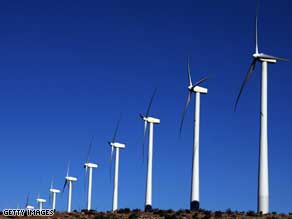...The transmission question is one that threatens to torpedo even the industry’s great white-water hope: offshore wind farms. MIT Technology Review reports on a potential breakthrough for offshore wind—floating, rather than fixed, platforms. By borrowing from the oil industry and floating above the sea-bed, wind farms could move as much as 20 miles offshore—with better wind and fewer angry locals—and save a bundle on construction costs, making wind theoretically competitive with traditional power sources.
What does the MIT article leave out? Transmission costs—the same that helped sink Long Island’s proposed offshore wind farm and have for years hogtied European offshore efforts. No matter how much cheaper capital costs for turbine installation become, all those spinning blades are just treading water until there’s a cost-effective and reliable way to hook them up to the grid.
From CNN we get part of the answer:
(ya still need lines to the grid)
Where to store wind-powered energy? Under water!
Since it became a viable energy resource around 20 years ago, wind power has emerged as a leading renewable technology.
Wind power is a success story of renewable energy.
Finding a way to store the power it generates would
increase its contribution to overall energy provision.
At the end of 2006 the worldwide capacity of all wind turbines was close to 75 gigawatts, which represents around one percent of all electricity use in the world.
Three quarters of that wind power usage is currently based in Europe. The Danes lead the way with nearly 20 percent of their electricity created by wind. They are followed by Germany, which generates around half that amount and Spain around seven percent.
But although it's clean, plentiful and relatively cheap, there is an inherent problem with wind power. It's not always there when you need it, leaving more conventional, more polluting energy resources to take up the slack.
The wind's variability has been one of the sticking points for wind power growth in the UK energy market. Given the UK's famously inclement weather and its island status -- which offers unrivalled offshore facility - you might think that wind power capacity was being filled at a rate of knots.
But in reality, wind power currently contributes about one percent of the UK's energy needs, with around 2000 on and offshore turbines up and running....
...The prospects for wind power could be greatly enhanced if cost-effective storage could be implemented. Some, like Minnesota based Xcel Energy, are putting their faith in new battery technology. But a UK professor, Seamus Garvey thinks he might have found another solution -- storing energy in flexible containers on the ocean floor.
Professor Garvey's idea of using Compressed Air Energy Storage (CAES) isn't a new one, but his methods are....MORE
*If you read the post, don't miss the comments by "JB" and "Russ Doty". Although defensive and snotty they really add nothing.I'm not sure if they understand that the WSJ guy, Keith Johnson, is so into this stuff that he uses a shorthand that assumes intelligence and knowledge on the part of his readers, something you'll get here, too, which is why I recognize it. And for which I am rewarded with that inner peace that comes from being correct in an assumption.